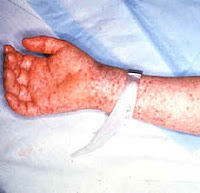While many of us are taking advantage of the warm weather and spending more time outdoors, it’s important to protect ourselves from ticks in order to avoid illness. This week we are highlighting the symptoms, treatment, and prevention methods for Rocky Mountain Spotted Fever. Rocky Mountain Spotted Fever (RMSF) is a bacterial disease that is transmitted through the bite of an infected tick. It damages the lining of the smallest blood vessels causing them to leak or form clots. If left untreated, RMSF can cause serious damage to internal organs, especially the kidneys, and can even be fatal.
RMSF was first discovered in the Rocky Mountains, but is most common in the southeast and can be transmitted by ticks in all parts of the United States. In the western U.S., the bacteria are carried by wood ticks, and in the eastern U.S. they are carried by the dog tick. Other ticks spread the infection in the southern U.S. Most cases occur during spring and summer months. However, if fall and winter are mild, ticks remain active and people venture outdoors, further extending the season of risk for RMSF.
Risk Factors
· Hiking or exposure to ticks in an area where the disease occurs
· Crushing ticks that have been removed from pets with bare fingers
Symptoms
Symptoms typically occur within 2 to 14 days after the tick bite and may include the following:
· Confusion
·
· Severe headache
· Muscle pain
· Red, non-itchy rash – usually appears a few days after the fever on the wrists and ankles and then spread to the rest of the body. The spots are 1-5 mm in diameter. About 1/3 of infected people do not experience a rash.
· Fatigue
· Diarrhea
· Light sensitivity
· Hallucinations
· Loss of appetite
· Nausea and vomiting
· Thirst
Although many of these symptoms are also caused by other common illnesses, making RMSF difficult to diagnose, there are several tests that can be done to properly diagnose the disease.
Treatment
Treatment with oral antibiotics usually cures the infection, especially if started within 5 days of infection. Complications are rare but may occur in cases that are left untreated for too long. Complications may include brain damage, clotting problems, heart, kidney, or lung failure, meningitis, pneumonitis (lung inflammation), or shock.
Call your health care provider if you experience the symptoms listed above after exposure to ticks or a tick bite, even if you did not see a tick on you.
Prevention
The best way to avoid RMSF is to take certain precautions when spending time outdoors. Your efforts will protect you from more than just RMSF, since ticks may carry other diseases.
· Wear light-colored clothing so you can see a dark tick and remove it before it finds your skin
· Wear long sleeves and long pants to reduce exposed skin
o Tuck shirt into pants
o Tuck pants into socks
· Wear shoes or boots instead of sandals
·
· Always perform a tick check on you and loved ones after spending time outdoors
· Remove ticks immediately with tweezers, pulling carefully and steadily. Pay attention to symptoms over the next two weeks and notify your doctor if symptoms appear.
Enjoy summer and fall outdoors but always remember to take precautions against outdoor pests, like ticks.





No comments:
Post a Comment